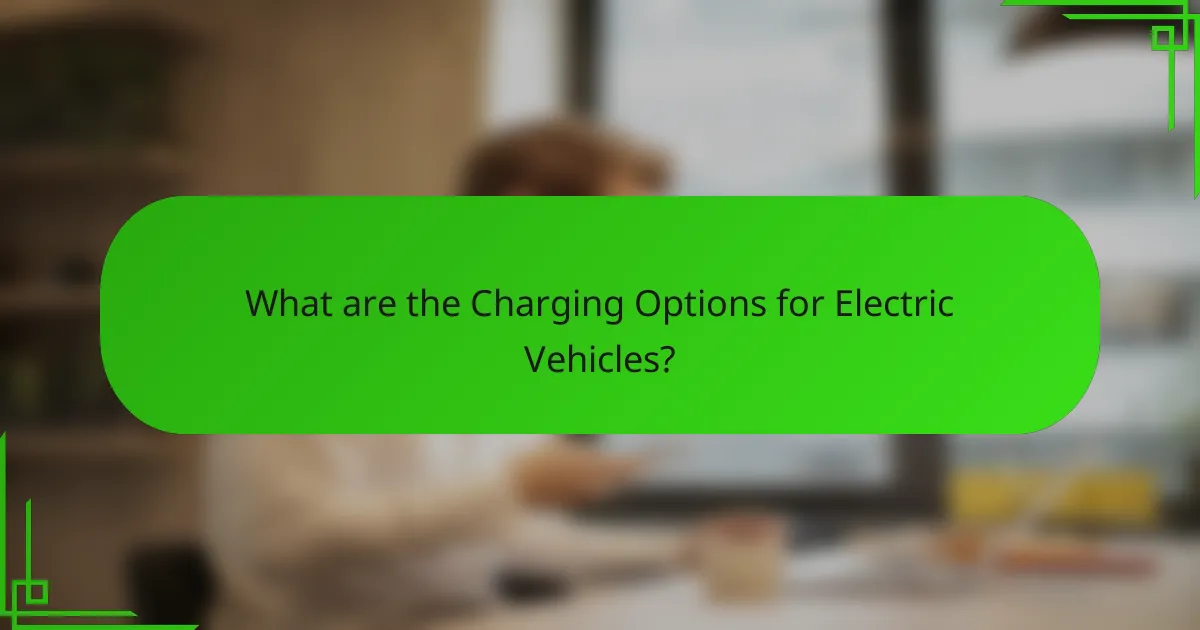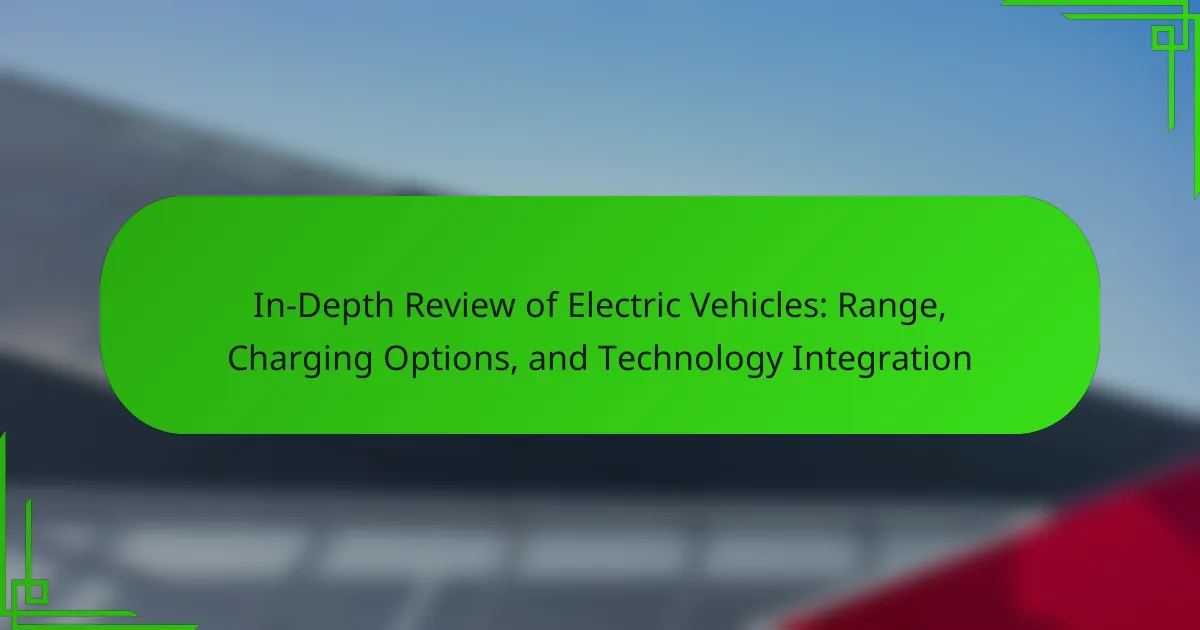Electric vehicles (EVs) are automobiles powered primarily by electricity, utilizing electric motors and rechargeable batteries for propulsion. This article provides an in-depth review of EVs, focusing on their range, charging options, and technology integration. It examines the efficiency of electric motors, the environmental benefits of zero tailpipe emissions, and the advancements in battery technology that enhance vehicle range, which varies by model. Additionally, the article outlines various charging methods, including Level 1, Level 2, and DC fast charging, addressing the implications of charging infrastructure on EV adoption. Overall, it highlights key factors influencing consumer acceptance and the ongoing developments in the electric vehicle market.

What are Electric Vehicles and How Do They Function?
Electric vehicles (EVs) are automobiles powered primarily by electricity rather than traditional fossil fuels. They utilize electric motors for propulsion, which are fed by energy stored in rechargeable batteries. EVs convert electrical energy into mechanical energy, allowing for efficient movement. The most common type of EV is the battery electric vehicle (BEV), which runs solely on battery power.
Charging stations provide the necessary electricity to recharge EV batteries. These stations can be found in public locations and at home. EV batteries typically have a range of 100 to over 300 miles on a single charge, depending on the model.
The efficiency of electric motors contributes to lower energy consumption compared to internal combustion engines. EVs also produce zero tailpipe emissions, reducing air pollution. The growing infrastructure for charging and advancements in battery technology are driving the adoption of electric vehicles globally.
What types of electric vehicles are available?
Battery Electric Vehicles (BEVs), Plug-in Hybrid Electric Vehicles (PHEVs), and Hybrid Electric Vehicles (HEVs) are the main types of electric vehicles available. BEVs operate solely on electric power and have no internal combustion engine. They rely on electric charging stations for power. PHEVs combine a traditional gasoline engine with an electric motor. They can run on electric power alone for a limited range before switching to gasoline. HEVs use both an electric motor and a gasoline engine but do not require external charging. They recharge their batteries through regenerative braking and the gasoline engine. These categories cover the primary options for consumers interested in electric vehicles.
How do battery electric vehicles differ from plug-in hybrids?
Battery electric vehicles (BEVs) operate solely on electric power, while plug-in hybrids (PHEVs) combine an electric motor with a gasoline engine. BEVs rely entirely on rechargeable batteries and produce zero tailpipe emissions. In contrast, PHEVs can switch between electric and gasoline power, offering flexibility in fuel options. BEVs typically have a longer electric range compared to PHEVs, which often have a limited electric-only range before switching to gasoline. According to the U.S. Department of Energy, BEVs can achieve ranges of over 300 miles, while PHEVs generally offer around 20 to 50 miles on electric power alone. Charging infrastructure also differs; BEVs require dedicated electric charging stations, while PHEVs can be charged at home and refuel at gas stations.
What are the unique features of fuel cell electric vehicles?
Fuel cell electric vehicles (FCEVs) utilize hydrogen as a fuel source. They convert hydrogen into electricity through a chemical reaction in the fuel cell. This process produces only water vapor as a byproduct, making them environmentally friendly. FCEVs offer fast refueling times, typically around five minutes. They have a longer driving range compared to battery electric vehicles, often exceeding 300 miles on a single tank. FCEVs operate efficiently in various climates and conditions. They also feature regenerative braking systems, which help improve energy efficiency. Additionally, FCEVs can contribute to energy storage solutions in a hydrogen economy.
What are the key components of an electric vehicle?
The key components of an electric vehicle include the battery, electric motor, and charging system. The battery stores electrical energy needed for propulsion. Most electric vehicles use lithium-ion batteries, known for their high energy density. The electric motor converts electrical energy into mechanical energy for vehicle movement. This motor is typically more efficient than internal combustion engines. The charging system enables the battery to be recharged from external power sources. This system includes onboard chargers and connectors compatible with various charging stations. Additionally, regenerative braking systems help recharge the battery during braking. These components work together to enhance the performance and efficiency of electric vehicles.
How does the electric motor work in an electric vehicle?
An electric motor in an electric vehicle converts electrical energy into mechanical energy. It operates based on electromagnetic principles. When electricity flows through the motor’s windings, it creates a magnetic field. This magnetic field interacts with permanent magnets or other windings. The interaction generates torque, which turns the rotor. The rotor is connected to the vehicle’s drivetrain. This process propels the vehicle forward. Electric motors are efficient, often exceeding 90% efficiency in converting energy. They provide instant torque, allowing for rapid acceleration.
What role does the battery play in electric vehicle performance?
The battery is essential for electric vehicle performance. It stores and supplies energy to the electric motor. This energy directly impacts the vehicle’s range, acceleration, and overall efficiency. A higher capacity battery allows for longer driving distances. Battery chemistry also influences charging speed and longevity. For example, lithium-ion batteries are commonly used due to their high energy density. According to the U.S. Department of Energy, advancements in battery technology have improved electric vehicle ranges significantly over the past decade. These enhancements contribute to better performance and consumer acceptance of electric vehicles.

What is the Range of Electric Vehicles?
The range of electric vehicles (EVs) varies significantly by model and battery capacity. Most modern electric vehicles have a range between 150 to 370 miles on a single charge. For example, the Tesla Model S Long Range can achieve approximately 405 miles. Factors affecting range include battery size, vehicle weight, and driving conditions. Additionally, advancements in battery technology continue to extend the range of newer models. Recent studies indicate that range anxiety is a key factor in consumer adoption of EVs. As technology progresses, manufacturers are focusing on increasing the efficiency and capacity of batteries.
How is the range of electric vehicles measured?
The range of electric vehicles is measured in miles or kilometers that the vehicle can travel on a single charge. This measurement is determined through standardized testing procedures. The most common testing standards include the EPA (Environmental Protection Agency) in the United States and WLTP (Worldwide Harmonized Light Vehicles Test Procedure) in Europe.
These tests simulate real-world driving conditions. They assess factors like acceleration, braking, and energy consumption. The results provide a baseline for consumers to compare different electric vehicle models. Real-world range may vary due to driving habits, terrain, and temperature.
For example, the EPA’s testing protocol includes a combination of city and highway driving scenarios. This ensures a comprehensive assessment of the vehicle’s performance. The measured range is crucial for consumers when evaluating the practicality of an electric vehicle.
What factors influence the range of an electric vehicle?
The range of an electric vehicle is influenced by several key factors. Battery capacity is a primary determinant, measured in kilowatt-hours (kWh). Larger batteries typically provide longer ranges. Vehicle weight also impacts range; heavier vehicles require more energy to operate. Aerodynamics play a crucial role; streamlined designs reduce drag and enhance efficiency. Driving conditions, including terrain and temperature, affect range as well. Cold weather can decrease battery efficiency, while hilly terrain can increase energy consumption. Driving habits, such as acceleration and speed, also influence how far an electric vehicle can travel on a single charge. Lastly, the efficiency of the electric motor and overall vehicle design contributes to range performance.
How does driving style affect electric vehicle range?
Driving style significantly impacts electric vehicle (EV) range. Aggressive driving, characterized by rapid acceleration and hard braking, can reduce range by up to 30%. Smooth acceleration and deceleration promote energy efficiency. Maintaining a steady speed also enhances range. Higher speeds typically consume more energy, leading to shorter distances. Additionally, frequent use of climate control systems can further decrease range. According to the U.S. Department of Energy, driving at 55 mph instead of 65 mph can improve range by 10-15%. Thus, adopting a conservative driving style is crucial for maximizing EV range.
What are the average ranges of popular electric vehicle models?
The average ranges of popular electric vehicle models vary significantly. Most mainstream electric vehicles offer ranges between 200 to 400 miles on a full charge. For instance, the Tesla Model 3 has an average range of approximately 353 miles. The Ford Mustang Mach-E averages around 300 miles, while the Chevrolet Bolt EV offers about 259 miles. The Hyundai Kona Electric provides a range of about 258 miles. These figures are based on EPA estimates and can fluctuate based on driving conditions and usage.
Which electric vehicles offer the longest ranges?
The electric vehicles offering the longest ranges include the Lucid Air, Tesla Model S Long Range, and Mercedes-Benz EQS. The Lucid Air has an impressive range of up to 520 miles on a single charge. The Tesla Model S Long Range follows closely with a range of approximately 405 miles. The Mercedes-Benz EQS provides around 350 miles of range. These figures are based on EPA estimates, which are widely recognized for their accuracy in measuring electric vehicle ranges.
How does range vary between different manufacturers?
Range varies significantly between different electric vehicle manufacturers. Each manufacturer employs distinct battery technologies and vehicle designs. For instance, Tesla models generally offer longer ranges due to advanced battery management systems. In contrast, smaller manufacturers may have shorter ranges due to less efficient battery use.
The range can also be influenced by factors like vehicle weight and aerodynamics. For example, lighter vehicles typically achieve better efficiency, leading to increased range. According to the U.S. Department of Energy, Tesla’s Model S Long Range can achieve approximately 405 miles on a single charge, while some compact electric vehicles may only reach around 150 miles.
Additionally, manufacturers like Chevrolet and Nissan have focused on affordability, which can result in reduced range compared to premium brands. Overall, the variation in range is a direct result of technological choices, design priorities, and market positioning by each manufacturer.

What are the Charging Options for Electric Vehicles?
Electric vehicles (EVs) have several charging options. These include Level 1 charging, Level 2 charging, and DC fast charging. Level 1 charging uses a standard 120-volt outlet. This method is slow, typically providing 3 to 5 miles of range per hour. Level 2 charging requires a 240-volt outlet. It can offer 10 to 60 miles of range per hour, making it suitable for home and public charging stations. DC fast charging is the quickest option. It can provide up to 80% charge in 30 minutes, depending on the vehicle and charger. Each charging option serves different needs and scenarios for EV owners.
What types of charging stations are available?
There are three main types of charging stations available for electric vehicles: Level 1, Level 2, and DC fast chargers. Level 1 charging stations use a standard 120-volt outlet. They provide a slow charging rate, typically adding about 4 to 5 miles of range per hour. Level 2 charging stations use a 240-volt outlet. They offer a faster charging rate, adding about 25 to 30 miles of range per hour. DC fast chargers provide rapid charging, using direct current. They can add up to 80% charge in 30 minutes or less, depending on the vehicle’s battery capacity. These types of charging stations cater to various needs based on charging speed and accessibility.
How do Level 1, Level 2, and DC fast charging differ?
Level 1, Level 2, and DC fast charging differ primarily in their charging speed and power output. Level 1 charging uses a standard 120-volt outlet and typically provides 2-5 miles of range per hour. This method is suitable for overnight charging at home. Level 2 charging operates at 240 volts, offering 10-60 miles of range per hour, making it ideal for home charging stations or public charging locations. DC fast charging, on the other hand, uses direct current and can deliver 60-350 miles of range in just 20-30 minutes. This method is commonly found at highway rest stops for quick recharging. The differences in voltage and charging speed make each level suitable for specific use cases and charging needs.
What are the benefits of home charging versus public charging?
Home charging offers several advantages over public charging. It provides convenience since vehicles can be charged overnight at home. This eliminates the need to find a public charging station during the day. Home charging typically costs less than public charging. According to the U.S. Department of Energy, electricity rates for home charging are generally lower than public charging fees.
Additionally, home charging allows for consistent charging habits. Owners can plug in their vehicles whenever they return home. This leads to a fully charged vehicle each morning. Home charging also avoids potential wait times at public charging stations. Public stations may be occupied, especially in busy areas.
Moreover, home charging can increase the lifespan of the vehicle’s battery. Regular, controlled charging is less stressful on the battery compared to fast public chargers. Overall, home charging provides a more economical, convenient, and efficient solution for electric vehicle owners.
What factors should be considered when charging an electric vehicle?
Charging an electric vehicle requires consideration of several key factors. The type of charger is crucial. Level 1 chargers are slower, while Level 2 chargers provide faster charging. Charging speed impacts how long the vehicle will be out of service. Battery capacity is another factor. Larger batteries take longer to charge. The state of charge affects charging time as well. A battery that is nearly empty will charge faster than one that is partially full. Ambient temperature can influence charging efficiency. Extreme temperatures may slow down the process. Additionally, charging infrastructure availability is important. Access to charging stations can affect convenience and planning for long trips. Lastly, cost of electricity can vary. This can influence the overall expense of charging the vehicle.
How does charging speed impact daily use of electric vehicles?
Charging speed significantly affects the daily use of electric vehicles (EVs). Faster charging reduces the time needed to recharge, allowing for more convenient use. For instance, a Level 3 DC fast charger can provide up to 80% charge in approximately 30 minutes. This quick turnaround enables drivers to make shorter stops during long trips.
In contrast, slower charging options, like Level 1 or Level 2 chargers, can take several hours to fully recharge an EV. This extended downtime can limit the vehicle’s usability, especially for those who need to make multiple trips throughout the day.
Moreover, charging speed influences the overall range anxiety experienced by EV users. A faster charging infrastructure increases confidence in the vehicle’s usability for longer journeys. According to a study by the International Council on Clean Transportation, increased charging speeds are correlated with higher EV adoption rates.
Thus, charging speed is a critical factor in the practicality and convenience of electric vehicle ownership.
What are the costs associated with charging an electric vehicle?
The costs associated with charging an electric vehicle include electricity rates, charging station fees, and installation costs. Electricity rates vary by location and can range from $0.10 to $0.30 per kilowatt-hour. Charging station fees may apply at public charging locations, typically between $0.10 and $0.40 per minute or a flat fee per session. Home charging installation costs can range from $500 to $2,000, depending on the electrical setup. Additionally, some utility companies offer time-of-use rates, which can lower costs during off-peak hours. Overall, the total cost to charge an electric vehicle can vary significantly based on individual circumstances and local infrastructure.
How can technology integration enhance the electric vehicle experience?
Technology integration enhances the electric vehicle experience by improving functionality and user engagement. Advanced navigation systems provide real-time traffic updates and route optimization. Smart charging solutions allow users to schedule charging during off-peak hours, saving costs. Over-the-air software updates ensure vehicles have the latest features and security enhancements. Connectivity with mobile apps enables remote monitoring of battery status and charging progress. Enhanced driver-assist features improve safety and driving comfort. Data analytics can optimize vehicle performance based on driving habits. Collectively, these technologies increase convenience and satisfaction for electric vehicle owners.
What role do apps and smart features play in electric vehicle management?
Apps and smart features are essential for electric vehicle management. They provide real-time data on battery status, range, and charging locations. Users can monitor their vehicle’s performance remotely. Smart features enable scheduling of charging times to take advantage of lower electricity rates. Apps also facilitate navigation to nearby charging stations. They often include features for locating available charging points. Additionally, some apps offer maintenance reminders based on vehicle usage. Overall, these tools enhance user experience and optimize vehicle efficiency.
How does vehicle-to-grid technology work and what are its benefits?
Vehicle-to-grid technology allows electric vehicles (EVs) to communicate with the power grid. It enables EVs to both draw energy from and supply energy back to the grid. When an EV is connected to the grid, it can store excess energy generated during off-peak hours. This stored energy can be released back to the grid during peak demand times.
The benefits of vehicle-to-grid technology include enhanced grid stability and reduced energy costs. It helps balance supply and demand, which can lead to fewer blackouts. EV owners can earn money or credits by selling stored energy back to the grid. This system encourages renewable energy use by providing a buffer for intermittent sources like solar and wind.
According to a study by the National Renewable Energy Laboratory, vehicle-to-grid systems can significantly reduce energy costs for consumers and improve overall grid efficiency.
What are some best practices for maximizing electric vehicle performance?
To maximize electric vehicle performance, maintain optimal battery charge levels. Keeping the battery between 20% and 80% enhances longevity and efficiency. Use regenerative braking to recover energy during deceleration. This process improves overall range by converting kinetic energy back into stored energy. Regularly update the vehicle’s software to ensure the latest performance enhancements and fixes. Proper tire maintenance is crucial; ensure tires are inflated to the manufacturer’s recommended pressure to minimize rolling resistance. Drive smoothly and avoid rapid acceleration or hard braking, as aggressive driving can deplete battery life quickly. Finally, utilize eco-driving modes if available, as they optimize power consumption for better efficiency.
Electric vehicles (EVs) are automobiles powered by electricity, utilizing electric motors and rechargeable batteries for propulsion. This article provides an in-depth review of electric vehicles, covering their types, including battery electric vehicles (BEVs), plug-in hybrids (PHEVs), and fuel cell electric vehicles (FCEVs). Key components such as batteries, electric motors, and charging systems are explained, along with the factors influencing EV range and charging options. Additionally, the article explores technology integration, including smart features and vehicle-to-grid technology, to enhance the overall electric vehicle experience.




